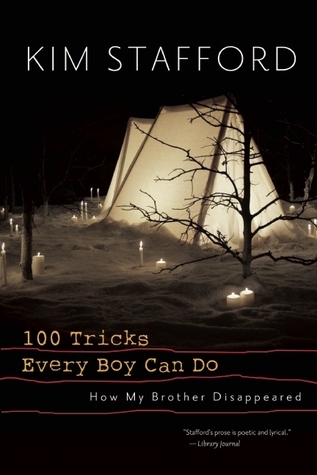100 Tricks Every Boy Can Do: How My Brother Disappeared by Kim Stafford
San Antonio, Texas. Trinity University Press. 2012. ISBN 9781595341365
 Kim Stafford’s moving memoir of loss and guilt about the suicide of his beloved brother, Bret, at age forty is brilliantly conceived and fascinatingly written. Told in small chunks of narrative anecdotes, it becomes both an exhaustive catalog of memories of the brothers’ shared moments of intimacy and isolation and a valiant attempt to understand the talented Bret’s descent into darkness.
Kim Stafford’s moving memoir of loss and guilt about the suicide of his beloved brother, Bret, at age forty is brilliantly conceived and fascinatingly written. Told in small chunks of narrative anecdotes, it becomes both an exhaustive catalog of memories of the brothers’ shared moments of intimacy and isolation and a valiant attempt to understand the talented Bret’s descent into darkness.
They were the oldest children (two sisters followed) of two teachers—the father, William Stafford, a celebrated poet and professor; the mother, a successful elementary school teacher. Kim, an author and professor, followed his father to a career at Lewis & Clark College, while Bret, the oldest, went from job to job, place to place, a devoted pacifist, but never found the niche that would have grounded him, settled him down in the turbulent era in which he lived (1948–88). His altruism was summed up in his words, “I work for the future. . . . I work for a generation beyond us,” but he never could put his thoughts and actions together enough to give him the satisfaction and fulfillment that would have saved him. “He lost job, house, and happiness—and then he went into personal darkness, stopped sleeping, became immune to consolation, and took his life.”
The brothers, from infancy on, were extraordinarily close. At night, from their side-by-side beds, they would chant their blessing poem, “Good night / God bless you / Have sweet dreams / See you tomorrow.” Kim observes, “We shared a room and a life as almost twins.” But long after Bret’s death, a friend of their father recalls Williams saying, ”I love all my children, but there is one who is myself—and that’s Kim”; readers also discover another clue into at least one aspect of the suicide: “My brother grew up in a house where he was not the son presumed by our father to inherit the kingdom.” So, as in all closely knit families, the suicide of one member haunts the others forever. The search for clues as to what went wrong is endless.
Bret did, however, have some successes: a BA from the University of Oregon, an MA from the University of Victoria, and one from Oregon State. He loved the outdoors and worked for seven summers for the US Forest Service, later as a land-use planner in Hood River, Oregon. But it wasn’t enough. Once, when Bret was visiting his now-successful brother at Lewis & Clark, Kim imagines Bret thinking, “So, little brother, you are teaching here where our father taught. You have a job, a desk, an assistant, and a program. And I have nothing. I, your older brother, have nothing. I’ve thrown it all away.”
In the telling of Bret’s story, Kim, so closely knit to his enigmatic sibling, also tells much of his own life—the long road through marriage and divorce and remarriage, through years of education to a PhD, and over three decades of teaching at Lewis & Clark. Both wanderers, restless seekers, often loners, one ending on Mount Adams, his ashes spread by mother, father, sisters, and Kim; and the other a successful author, teacher, poet, and father.
Kim Stafford spent years thinking this haunting story to its sad end, but like all authors and thinkers and teachers, he did it for others: his brother, himself, and for all of us. “For the work of memoir is to put personal memory in a form that may serve the memories of others.” This poignant book will serve well.
Marvin J. LaHood
Amherst, New York


